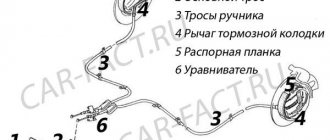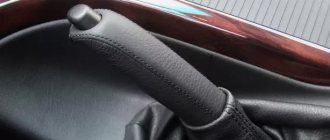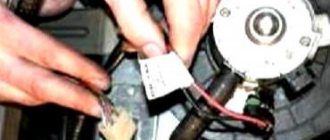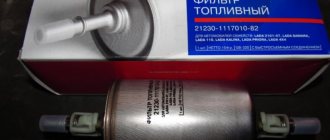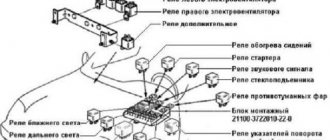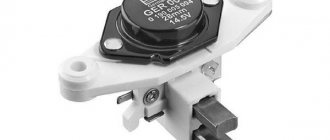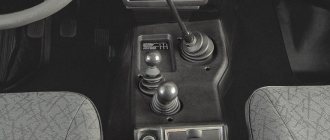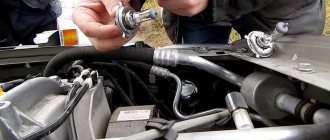How to replace the handbrake cable
Sometimes adjusting the handbrake does not bring the desired result due to the fact that the rear cable is overstretched. In this case, the only way out of the situation is to replace the Chevrolet Niva hand brake cable. In addition, the cable will have to be replaced if it regularly jams in the protective sheath or breaks due to wear.
- To carry out the replacement, the rear of the vehicle must be in a hanging position. Therefore, lift it using a lift or jack and remove the brake drums from the rear wheels.
- Using a “12” wrench, loosen the locknut on the adjusting rod and completely unscrew it together with the adjusting nut. You must first remove the spring from the rod, as it will not allow you to unscrew the nuts.
- After this, you can easily remove the cable equalizer and remove the cable itself from it.
- Next, by pulling the cable towards you, remove the ends of the shell from the brackets located on the left and right on the bottom of the body.
- Using manual force, remove the right and left branches of the cable from the rear axle beam brackets.
- Using a wrench, unscrew the bolts securing the holders to the brake flaps.
- Now, having disconnected the cable ends from the brake pad drive levers, pull it to remove it from the hole in the brake shield.
After dismantling, install a new Niva rear hand brake cable. To do this, also use these instructions, but perform all the steps in reverse order. And with this, the replacement of the Chevrolet Niva handbrake cable is completed, and finally, do not forget to adjust the degree of its tension. It is also important to lubricate the adjusting threads on the rod upon completion of the repair work to avoid problems with unscrewing the nuts during the next adjustment or replacement.
As on any other car, the Chevrolet Niva parking brake is an integral part of the braking system. Its purpose is to prevent spontaneous movement of the vehicle during parking or temporary parking with the engine running. But the handbrake can also replace the main brake system in the event of its failure, which allows you to safely get to the repair site.
You have to use the handbrake quite often, so its cable and brake pads are subject to intense wear. As a result, car owners over time have to take measures to adjust the system or replace its individual parts. While some people turn to a car repair shop for this, others prefer to carry out repair work themselves.
The design of the Chevrolet Niva parking brake differs little from similar systems in other passenger cars
The design of the parking brake of a Chevrolet Niva is quite simple and is not much different from similar systems in other passenger vehicles. It consists of the following main parts:
- Handbrake lever - serves to transmit the force of the human hand to the actuator, which, in turn, acts on the brake pads to lock the rear wheels.
- The handbrake cable is a carbide, specially manufactured steel wire that runs under the bottom of the vehicle and operates the brake pads on the rear wheels.
- Brake pads are the final elements of the brake system, made of friction materials. By pressing against the brake drum or disc, they immobilize the wheel.
The manual braking system also includes such functional elements as a spacer sleeve, a brake pad drive lever, a spring, a protective sheath for the rear cable, a cover for the front handbrake cable, and a ratchet mechanism for the lever.
The handbrake system contains many structural elements
Description of the Chevrolet Niva handbrake
The parking brake in a Chevrolet Niva, as in other cars, is an important component of the braking system. Frequent use of the handbrake leads to wear on the cable and brake pads. Therefore, over time, it is necessary to carry out repairs and replacements of worn-out parts of Chevrolet Niva parking brakes.
The parking brake serves for:
- Parking a car on slopes or slippery terrain.
- Temporary parking of a car, without turning off the engine.
- Additional braking.
- In case of failure of the main braking system.
The Chevrolet Niva parking brake has the same design as on all other car models. The design consists of the following parts that make up a single integral braking system for the rear wheels of the car:
- The handbrake is a lever that is activated by the efforts of a person’s hand, thereby bringing the rear wheels into a locked state. The handbrake consists of a lever, which is about 15 cm long, and covered mainly with decorative materials. The handbrake is located in the Chevrolet Niva (as in all cars) between the driver and passenger seats. It is activated by smoothly pulling the lever towards you. Return to the reverse position by pressing the button and smoothly move it down until it stops. The handbrake has from 3 to 7 squeeze (click) positions, it depends on the tension of the cable. The handbrake operates on the principle of a ratchet mechanism. If the brake cable is loose, the lever is tensioned up to 7 clicks.
- The tension cable is a special steel wire made from a special carbide material that operates the brake pads. The length of the cable on Niva is approximately 2 meters. And it is located under the bottom of the car, sometimes hidden in a rubber or plastic shell.
- Brake pads are an arc (backing) with a special layer (friction plate) that is pressed against the wheel rim, thereby blocking the wheel. Such pads are placed under the wheel rim and are hermetically sealed to prevent the entry of dust, dirt or moisture, which will lead to disruption of the handbrake and damage to its elements. Brake pads wear out quickly when the handbrake is used frequently while driving and require subsequent replacement.
Parking brake adjustment
Adjustment is carried out periodically or if a weakening of the tension cable is detected. It is not difficult to find out that the cable is loose; you will feel that the handbrake does not hold the car in various inclined planes. You can adjust the tension cable and, accordingly, the brake system itself by performing simple sequential steps. It is necessary to drive the car into the inspection hole, or you can do without it, but it will not be very convenient.
To do this, set the handbrake lever to its extreme position towards the floor. In this position of the handbrake, the rear wheels should rotate freely. After this, we lower ourselves into the inspection hole and begin adjusting the cable tension. It is necessary to first unscrew the lock nut with a thirteen wrench, and then begin to tighten the main adjusting nut, while counting the number of turns made.
Tighten the cable three to four turns of the nut, after which you need to squeeze the lever and check at what click the handbrake keeps the wheels stationary. The handbrake is considered normal when the wheels lock at the fifth click. Wheel locking is checked by trying to move the car. After the cable is adjusted, it is necessary to tighten the lock nut all the way to the main nut, and after this the hand parking brake can be considered working.
How to check and adjust the tension of the handbrake cable
If the parking brake is able to hold the car stationary on a 25% slope, then it is doing its job as expected. If you pull the handbrake lever seven ratchet clicks or more, but the car still rolls, the conclusion is the following: the handbrake system is not working effectively.
In such a situation, adjustment of the Chevrolet Niva hand brake is required. This type of repair is simple, performed relatively quickly and does not require the use of special equipment. All you need for work are two keys “12”, pliers and a jack if it is not possible to put the car on the inspection hole.
To work, you need to put the Chevrolet Niva on the inspection hole
- First, check whether the handbrake really does not hold the car on the road at a slope of 25%. To do this, place the vehicle on an overpass or find a suitable section of road. If the problem occurs, then we proceed to adjustment.
- Setting the optimal parking brake cable tension is done under the car, so it is better to place it above the inspection hole. If this is not possible, use a lift or jack. In any case, the rear of the car must be raised.
- When the vehicle is ready for use, secure it and release the handbrake lever.
- Next, using a wrench, loosen the lock nut on the handbrake adjusting rod, then use a second identical wrench to tighten the adjusting nut until the cable is properly tensioned. By the way, pliers are needed to keep the rod from turning during the adjustment process.
- Now tighten the locknut and make a full stroke first to the working position, and then lower it. After this, spin each rear wheel by hand. The rotation must be uniform, jerking is not allowed. If any are felt, adjusting the Chevrolet Niva handbrake requires repeating.
And also interesting: VAZ 21214 brake system bleeding.
Video on the topic And the last stage - testing the handbrake in road conditions. That is, you need to carry out a standard check of the parking brake's effectiveness, as described in the first paragraph of the manual.
After assembly, the handbrake must be tested in road conditions.
Parking brake adjustment
How to tighten the handbrake on a Chevrolet Niva, given that loosening its cable can lead to serious trouble? First of all, let's understand the basic parts of the parking brake.
Its structure (main details):
The release of the handbrake in a Chevrolet Niva is checked as follows : you need to drive up a slope and pull the handbrake lever towards you until it stops. If the lever makes 5-7 clicks and securely locks the car, then there is no need to adjust it. And if there were more clicks, but the car is still not fixed, it means that the second cable needs to be tightened.
It's done like this:
Attention! The setting and operation of the parking brake is considered normal if the lever is tightened by 5-7 clicks and at the same time securely fixes the wheel (you can check this by driving onto a slope). After the handbrake lever is lowered to its lowest position, there is no extraneous sound when turning the rear wheel.
Replacing a short handbrake cable on a Chevrolet Niva
As I wrote earlier, slowly but surely, my handbrake cable was getting damaged, and the cable jacket was calloused. Finally, it got warmer outside from -25 to -3, and it was stupid to miss the last days of vacation.
I didn’t think that you might not find spare parts in stock for a Russian-made car, but ShNG is a different story. I drove around all the shops in the city, and everywhere I say that I have one cable like on 2106 or 2121, they stare at me and either snub 2 cables, or try to sell me from 21 Niva.
A week ago, I poured motor oil into the cable jacket and hung it so that it spread along the entire length. On the third day, it started dripping from the second end of the shirts, which means everything was lubricated as it should. Now the cable will not freeze if water gets inside, and it will not rot either. I also cut the springs on the cables, an old technique worked on the nine and six, why not do it on the field.
When replacing everything is standard, we hang up the axle, take off the wheels, take off the drums, but here’s the problem. The old owner left a gift, where there should be a threaded hole for removing the drum, a piece of a bolt sticks out, and it was not possible to tighten it with one bolt until I heated it with a gas burner. Upon further inspection of the drum, I find a second jamb.
The cable served 120 thousand kilometers in 2 years 8 months, which is not bad in principle) For the last 2 weeks I drove without a handbrake - it’s somehow unusual, so today I replaced the old tired cable. Since the BBC did not have a cable for the shniva in stock at that time, I bought it The officials sold it for 400 rubles; in the store it would have been 70 rubles cheaper. Special thanks to Ivanokk, who kept up the conversation in the garage and poured fresh kvass into the mug)
First, remove the spring and unscrew the locknut and nut that tension the cable. Remove the washer and guide plate. If the tension nut does not unscrew, but turns together with the front cable, use WD 40 to help and hold the front cable with pliers.
We counter, install the spring, rejoice at the working handbrake))
The mechanically actuated parking brake system acts on the brake mechanisms of the rear wheels.
The parking brake is mechanically driven from lever 1 (Fig. 1).
The middle part of the rear cable passes through the groove of guide 7, the tension of which is adjusted with a nut screwed onto the threaded end of the front cable.
A spacer sleeve 8 is installed between the guide 7 and the adjusting nut.
Rice. 1. Parking brake drive parts
At the rear ends of the cable there are tips, each of which is connected to the hook of the lever 11 for the manual drive of the shoes.
This lever is pivotally attached to the brake shoe with a finger and its upper part rests against the groove of the spacer bar 10.
The rib of the brake pad is installed in the opposite groove of the bar.
Parking brake. Chevrolet Chevrolet-Niva
Rice. 8.9. Parts of the parking brake drive: 1 – lever; 2 – button; 3 – thrust spring; 4 – latch rod; 5 – cover; 6 – front cable; 7 – rear cable guide; 8 – spacer sleeve; 9 – tension spring; 10 – spacer bar; 11 – lever for manual drive of the pads; 12 – rear cable
The parking brake is mechanically driven from lever 1 (Fig. 8.9). The middle part of the rear cable passes through the groove of guide 7, the tension of which is adjusted with a nut screwed onto the threaded end of the front cable. A spacer sleeve 8 is installed between the guide 7 and the adjusting nut.
At the rear ends of the cable there are tips, each of which is connected to the hook of the lever 11 for the manual drive of the shoes. This lever is pivotally attached to the brake shoe with a finger and its upper part rests against the groove of the spacer bar 10. The rib of the brake shoe is installed in the opposite groove of the bar.
Replacing the rear parking brake cable
Replace the rear cable if it is excessively stretched (impossibility of adjusting the parking brake), mechanical damage and loss of mobility in the sheath.
You will need: keys “8”, “13” (two), cobra pliers, pliers.
1. Remove the brake drum (see “Removing and installing the brake drum”).
2. Loosen the locknut on the front cable end.
3. While holding the tip from turning with pliers, unscrew the locknut and adjusting nut to the end of the tip.
4. Remove the spring.
5. While holding the tip from turning, remove the lock nut, adjusting nut, and spacer from the tip.
6. Remove the guide from the end and disconnect it from the cable.
7. Remove the cable from the rear axle beam bracket and.
8. . from the body bracket hole.
9. Remove the two bolts securing the cable sheath holder to the brake shield.
10. Disconnect the end of the parking brake cable from the drive lever.
11. Pull the cable out of the hole in the brake shield.
12. Similarly, remove the right branch of the cable and remove the rear cable from the car.
13. Install the new cable on the vehicle in the reverse order of removal.
14. Adjust the parking brake system (see “Checking and adjusting the parking brake”).
Replacing the parking brake lever and front cable
Replace the lever assembly if the gear sector or pawl is worn or damaged.
Replace the front cable if it is excessively stretched (impossibility of adjusting the parking brake) or has mechanical damage.
You will need: a 13mm wrench, pliers, a screwdriver.
1. Disconnect the rear cable with guide from the end of the front cable (see “Replacing the rear parking brake cable”).
2. Remove the floor tunnel lining (see “Removing and installing the floor tunnel lining”).
3. Remove the two bolts securing the lever bracket to the floor and remove the lever.
4. Remove the lever axle retaining ring.
5. Remove the lever shaft.
6. Pull the cable inside the cabin.
7. Install the new cable and lever in the reverse order of removal.
8. Adjust the parking brake system (see “Checking and adjusting the parking brake”).
Replacing the rear parking brake cable
Replace the rear cable if it is excessively stretched (impossibility of adjusting the parking brake), mechanical damage and loss of mobility in the sheath.
You will need: keys “8”, “13” (two), cobra pliers, pliers.
Also interesting: How to bleed the brakes of a Niva Chevrolet
Loosen the locknut on the front cable end.
While holding the tip from turning with pliers, unscrew the lock nut and the adjusting nut to the end of the tip.
While holding the tip from turning, remove the lock nut, adjusting nut and spacer from the tip
Remove the guide from the tip and disconnect it from the cable
Remove the cable from the rear axle beam bracket and.
. from the body bracket hole.
Remove the two bolts securing the cable sheath holder to the brake shield.
Disconnect the end of the parking brake cable from the drive lever
Pull the cable out of the hole in the brake shield
Similarly, remove the right branch of the cable and remove the rear cable from the car.
Install the new cable on the vehicle in the reverse order of removal.
Replacing parking brake cables
All models under consideration are equipped with an airbag. The airbag is constantly in an “alert” state and can operate (inflate) at any time when the battery is connected. To prevent accidental airbag deployment (and resulting injury), turn the ignition key to the LOCK position and disconnect the negative cable from the battery whenever performing any work on any safety system components.
| Replace the rear parking brake cable if it is excessively stretched (impossibility of adjusting the parking brake), or if there is mechanical damage to the cable strands or its sheath. Each brake mechanism of the rear wheels is driven by a separate cable. Removal and installation of the left cable are shown. The right cable is removed and installed in the same way.
1. Loosen the tension of the drive cables by unscrewing the adjusting nut to the very end of the threaded end of the front cable (see paragraphs 1 and 2 “Replacing the front parking brake cable”), but without removing the nut completely. 2. Disconnect the end of the rear drive cable from the equalizer by moving it out of the equalizer slot. 3. After unscrewing the fastening nuts, remove the cable support bracket on the fuel tank shield... 4. ...then the front one... 5. ...and rear holders on the body... 6. ...as well as a holder on the rear suspension arm. 7. Using a screwdriver, remove the installation sleeve of the cable sheath from the bracket on the base of the body... 8. ...and remove the cable from the bracket hole. 9. Remove the brake drum (see “Removing and installing the brake drum”). 10. Use a screwdriver to press the release lever forward... 11. ...and use pliers to disconnect the cable tip from the release lever. 12. On the back side of the brake shield, remove the spring clamp of the cable sheath... 13. ...and, pulling the cable through the hole in the shield, remove it from the car. 14. Install the rear parking brake cable in the reverse order of removal. 15. Adjust the parking brake system (see “Adjusting the parking brake drive”). Rice. 8.9. Parts of the parking brake drive: 1 – lever; 2 – button; 3 – thrust spring; 4 – latch rod; 5 – cover; 6 – front cable; 7 – rear cable guide; 8 – spacer sleeve; 9 – tension spring; 10 – spacer bar; 11 – lever for manual drive of the pads; 12 – rear cable The parking brake is mechanically driven from lever 1 (Fig. 8.9). The middle part of the rear cable passes through the groove of guide 7, the tension of which is adjusted with a nut screwed onto the threaded end of the front cable. A spacer sleeve 8 is installed between the guide 7 and the adjusting nut. At the rear ends of the cable there are tips, each of which is connected to the hook of the lever 11 for the manual drive of the shoes. This lever is pivotally attached to the brake shoe with a finger and its upper part rests against the groove of the spacer bar 10. The rib of the brake shoe is installed in the opposite groove of the bar. 1. Remove the brake drum (see “Removing and installing the brake drum”). Also interesting: Engine crankcase ventilation system, EGR valve, device, operating principle of PCV, diagram, how to check, cleaning - 2. Loosen the locknut on the front cable end. 3. While holding the tip from turning with pliers, unscrew the locknut and adjusting nut to the end of the tip. 4. Remove the spring. 5. While holding the tip from turning, remove the lock nut, adjusting nut, and spacer from the tip. 6. Remove the guide from the end and disconnect it from the cable. 7. Remove the cable from the rear axle beam bracket and. 8. . from the body bracket hole. 9. Remove the two bolts securing the cable sheath holder to the brake shield. 10. Disconnect the end of the parking brake cable from the drive lever. 11. Pull the cable out of the hole in the brake shield. 12. Similarly, remove the right branch of the cable and remove the rear cable from the car. 13. Install the new cable on the vehicle in the reverse order of removal. 14. Adjust the parking brake system (see “Checking and adjusting the parking brake”). Replacing the parking brake lever and front cable Replace the lever assembly if the gear sector or pawl is worn or damaged. Replace the front cable if it is excessively stretched (impossibility of adjusting the parking brake) or has mechanical damage.
1. Disconnect the rear cable with guide from the end of the front cable (see “Replacing the rear parking brake cable”). 2. Remove the floor tunnel lining (see “Removing and installing the floor tunnel lining”). 3. Remove the two bolts securing the lever bracket to the floor and remove the lever. 4. Remove the lever axle retaining ring. 5. Remove the lever shaft. 6. Pull the cable inside the cabin. 7. Install the new cable and lever in the reverse order of removal. 8. Adjust the parking brake system (see “Checking and adjusting the parking brake”). Now the cable will not freeze if water gets inside, or even rot. I also cut the springs on the cables, an old technique worked on the nine and six, why not do it on the field. Full size Pull the cable out of the groove in the holder. Next, remove the wheel, unscrew the screw with a 12mm wrench; on old cars there are two screws on the drum and remove the drum. I did this in less than a minute, because when I changed the rear pads at thousands of miles, I lubricated the adjacent plane of the hub with lithol. https://www.youtube.com/watch?v=ZDgQo2otkpk I decided to write down interesting points. If you have any questions, write in the comments - post Replacement of rear brake pads NIVA sp. We change the Niva brake pads ourselves http: How to change the handbrake lever on a Chevrolet Niva rear brake pads.
|
Chevrolet Niva | Replacing parking brake cables
Replacing parking brake cables
All models under consideration are equipped with an airbag. The airbag is constantly in an “alert” state and can operate (inflate) at any time when the battery is connected. To prevent accidental airbag deployment (and resulting injury), turn the ignition key to the LOCK position and disconnect the negative cable from the battery whenever performing any work on any safety system components. After disconnecting the cable from the battery, wait at least two more minutes before proceeding (the system is equipped with a capacitor that takes time to discharge). For more information about the operation of the security system, see Chapter On-board electrical equipment system.
Replacing the hand brake cable on a Chevrolet Niva video. Replacing the hand brake cable on a Niva Chevrolet
Replacing hand brake cables on a Chevrolet 410. Part 1.
Niva. Here's the handbrake!
Chevrolet Niva replacing rear brake pads
Adjusting the NIVA hand brake. We tighten the Niva hand brake cable ourselves
How to change a short parking brake cable on a Shnivy?
I tighten the handbrake of Chevrolet Niva 4x4 Chevrolet Niva 2016
AUTO repair. How to lubricate the parking brake cable
Chevrolet Niva heater damper repair
How to lubricate the handbrake cable yourself
Changing the handbrake cable and straightening the bumper on the Niva #AutoFormula 4x4
- Replacing the trapezium wipers on a Chevrolet Lanos video
- Road accident in Yurga video
- BMW 540 e39 video
- Toyota East 4WD video
- Niva Chevrolet driving in mud video
- Video about Opel Mocha
- Toyota camry test drive anton avtoman
- Evdokimov accident video
- Kamaz 65225 log carrier video
- Kia Sorento 2021 test drive video in Russia
- Test drive Mitsubishi Galant 1999 video
- Video of replacing a Toyota Avensis fog lamp
- Crash test Volvo 440 video
- Nissan X Trail 2004 test drive video
- Mercedes Vito timing chain replacement video
Home » Choice » Replacing the hand brake cable Niva Chevrolet video
Read news about the new Niva
- Brake system Chevrolet Niva
- Bleeding Chevrolet Niva brakes: step-by-step instructions
- How to bleed brakes on a Chevrolet Niva correctly
- How to bleed the brakes of a Niva Chevrolet || Chevrolet Niva brakes are pumped
- How to bleed brakes on a Chevrolet Niva correctly
- Niva Chevrolet front hub repair || Niva brake pedal price
- The design of the Chevrolet Niva brake system and its diagram
- How to Check for Signs of a Bad Brake Booster
